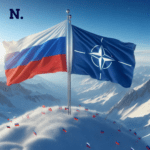According to the Pentagon, the Ukrainian military can use longer-range missiles supplied by the US for self-defense. This permission allows targeting locations inside Russia. The permission extends beyond just the front lines near Kharkiv. This reflects a significant shift in U.S. policy. The aim is to bolster Ukraine’s defensive capabilities against Russian aggression.
Easing of Restrictions by Pentagon
President Joe Biden first relaxed the limitations on Ukraine’s use of US-supplied weapons. This was to give Ukraine an additional line of defense against Russian missile assaults on Kharkiv. Since the start of Russia’s invasion, the US has forbidden Ukraine from attacking targets within Russia using US-supplied weapons. This was to prevent the conflict from escalating. However, officials required a policy reevaluation. The change was due to the continuous exploitation of Russian territory as a launching pad for strikes.
Russia’s Use of Territory as a “Safe Zone”
Maj. Gen. Pat Ryder said that Ukraine has the right to self-defense and the ability to retaliate when Russian soldiers undertake operations from across the border. Ryder made it clear that rather than being a new policy, this permissions modification is a reaction to the tactical reality on the ground.
Clarification by Pentagon on Policy
Army Maj. Charlie Dietz, a Pentagon spokesman, clarified the expanded permissions. He said common sense, not geography, grounds them. Dietz explained the rationale behind the permissions. If Russia is attacking or preparing to attack from its territory, Ukraine can retaliate. Ukraine can target those forces. Dietz also mentioned the use of U.S.-supplied air defense systems. Ukraine can target Russian planes even in Russian airspace. This permission applies if those planes are about to attack Ukraine.
Increased Support Amid Escalating Attacks
In response to the escalating Russian attacks on Ukrainian energy infrastructure, the White House announced the expedited delivery of air defense interceptor missiles to Ukraine. The U.S. is redirecting these shipments from planned deliveries to other allied nations. The urgency of this support reflects the intensified Russian military campaign targeting Ukrainian cities and critical infrastructure, particularly as winter approaches.
Consistent Stream of Interceptors
The U.S. has been consistently supplying Ukraine with interceptors for its air defense systems. These include Patriot missile batteries and the National Advanced Surface-to-Air Missile Systems (NASAMS). National security spokesman John Kirby provided an update on the situation. He stated that more interceptors were urgently needed. This need arises because Russia’s military has ramped up missile and drone attacks. These attacks target Ukrainian infrastructure. The rushed shipments are expected to include hundreds of Patriot missiles, which are crucial for Ukraine’s defense.
Strategic Implications of the Policy made by Pentagon
This policy shift by the U.S. has significant strategic implications. The United States aims to undermine Russia’s strategic edge by enabling Ukraine to target Russian military within Russian territory. This involves conducting assaults on areas that are thought to be secure. This move could potentially deter further Russian aggression by increasing the risks associated with their cross-border operations.
Ensuring Defensive Capabilities
The prompt delivery of interceptors and air defense systems demonstrates the United States’ commitment to ensuring that Ukraine has strong defensive capabilities. By shielding Ukrainian towns and infrastructure from the stepped-up Russian military onslaught, the continued support seeks to strengthen Ukraine’s resistance to the current attack.
Broader Context of US Support
From the start of the Russian invasion, the United States has continuously supported Ukraine diplomatically and militarily. The most recent changes in strategy and the increased degree of support are a determined response to the evolving character of the conflict. The US shows that it is committed to defending Ukraine’s sovereignty and territorial integrity by modifying its stance.
Potential Risks and Reactions
While the U.S. intends the expanded permissions for Ukraine to strike within Russian territory to bolster its defense, these permissions also carry potential risks. The escalation could provoke stronger retaliatory measures from Russia, potentially broadening the conflict. However, the U.S. and its allies likely assess that the benefits of enabling Ukraine to defend itself more effectively outweigh the risks of further escalation.
Conclusion
A major shift in policy has occurred with the Pentagon’s decision to let Ukraine to utilize longer-range missiles supplied by the United States for self-defense. This move reflects a pragmatic response to the tactical realities of the conflict, aiming to strengthen Ukraine’s defensive capabilities against Russian aggression. The U.S. commitment to Ukraine’s security is emphasized by the expanded support, which includes the quick delivery of air defense interceptors. As the conflict continues, the strategic implications of these decisions will play a crucial role in shaping the future of the Russia-Ukraine war and the broader geopolitical landscape.





